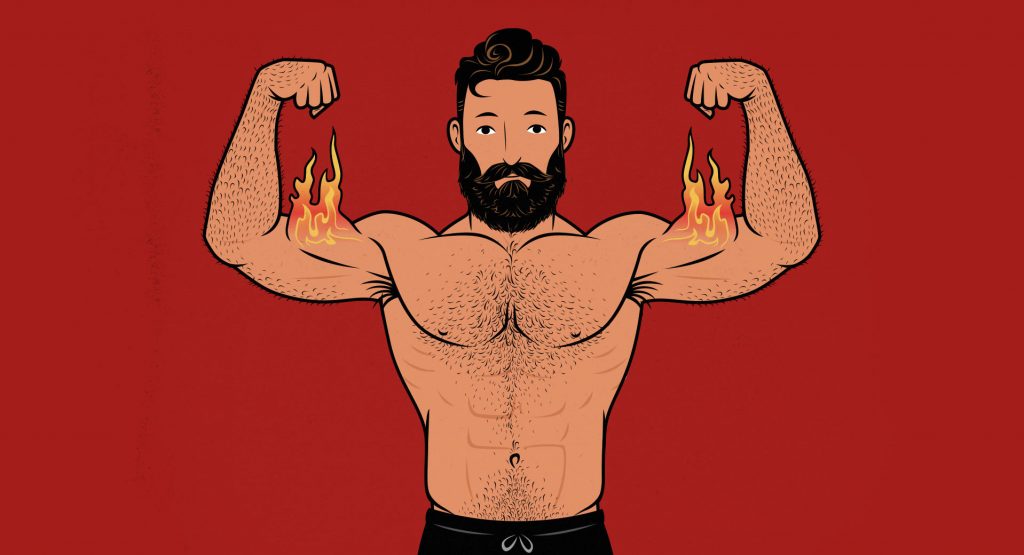
Review of the Max Size Workout Program by Athlean-X
Our specialty is hypertrophy training. More specifically, we help naturally skinny “hardgainers” bulk up. But before that, Marco worked as the strength coach for several college, professional, and Olympic athletes. He also interned under Eric Cressey, the strength coach overseeing the training of the Yankees. So we’ve got somewhat similar roots to Jeff Cavaliere. Not surprisingly, then, we get a lot of questions about his muscle-building program for skinny guys.
Max Size is Jeff Cavaliere’s workout program for hardgainers looking to build muscle. That’s the program that best lines up with our area of expertise. So let’s evaluate it based purely on how effective it is at helping skinny guys bulk up.
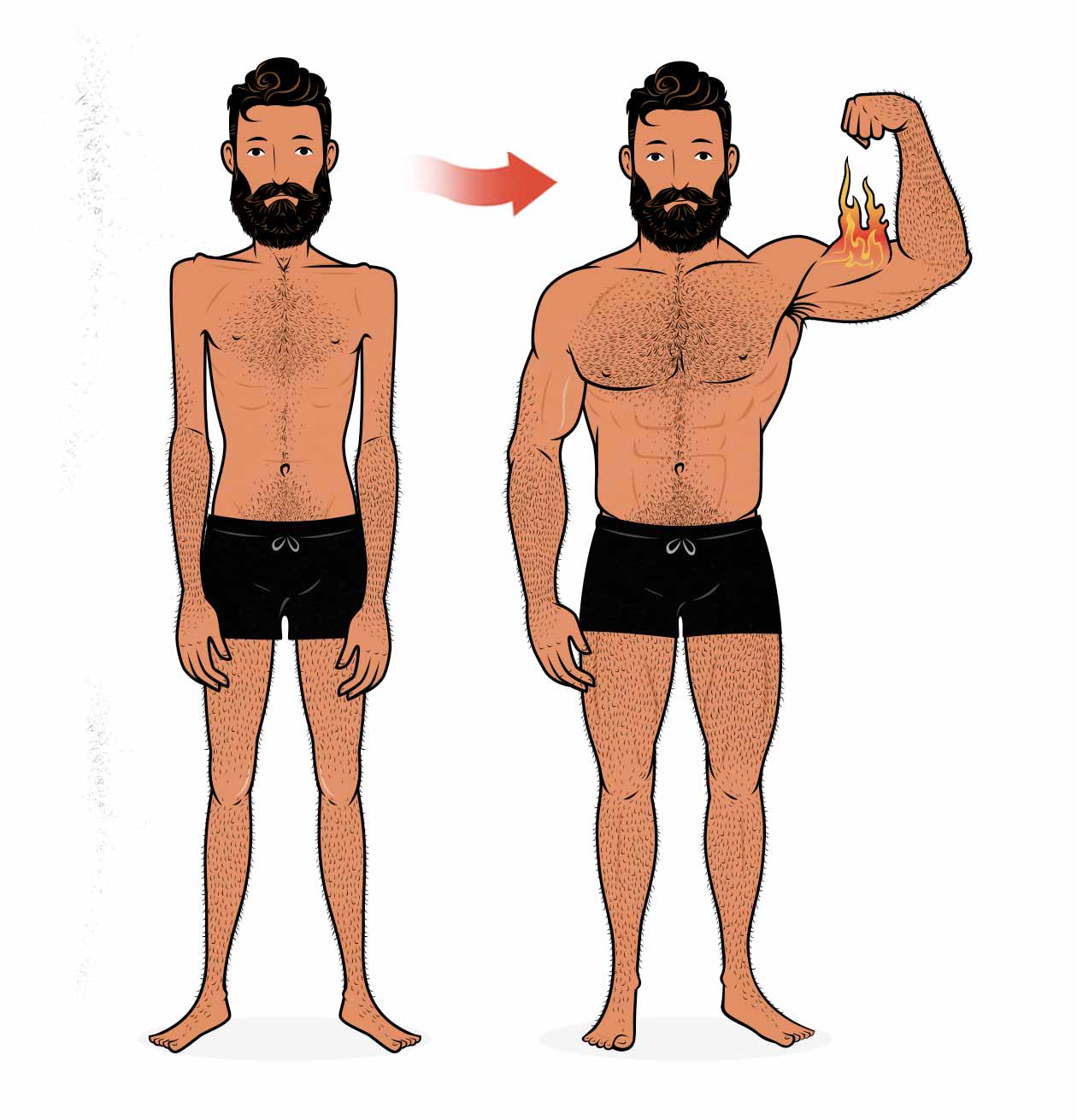
Introduction
Before we decided to build our careers around helping hardgainers build muscle, Marco was a strength and conditioning coach for high-level athletes, including college, professional, and Olympic football and rugby players here in Canada. After getting his degree and certifications, he then interned under Eric Cressey, the strength coach overseeing the strength and conditioning of the Yankees. We’ve got those same roots in athletics training as Jeff Cavaliere, and so a lot of our readers have been asking us what we think of his muscle-building program for hardgainers.
That also introduces somewhat of a problem. We’re naturally skinny guys ourselves, and I’ve personally gained 60 pounds at 11% body fat. Marco has gained almost 70 pounds. We then went on to create our Bony to Beastly and Bombshell blogs, and we’ve been working full-time helping skinny people bulk up for nearly ten years now. Helping hardgainers build muscle is our specialty, making us well-suited to reviewing this muscle-building program, but it also gives us a bias.
On the other hand, we’ve mainly heard great things about Athlean-X. We have a lot of members who did Jeff Cavaliere’s programs before coming to us. Not all of them succeeded at building muscle when doing the Max Size program, but many did. And more importantly, he got them into the habit of weight training. Anyone who can do that is doing a great thing.
Plus, we’re more than happy to say great things about great programs. Eric Cressey makes great bulking programs for athletes, Eric Helms makes great hypertrophy programs for intermediate bodybuilders, and Greg Nuckols makes great strength and hypertrophy programs for powerlifters. But even so, take this review with a grain of salt.
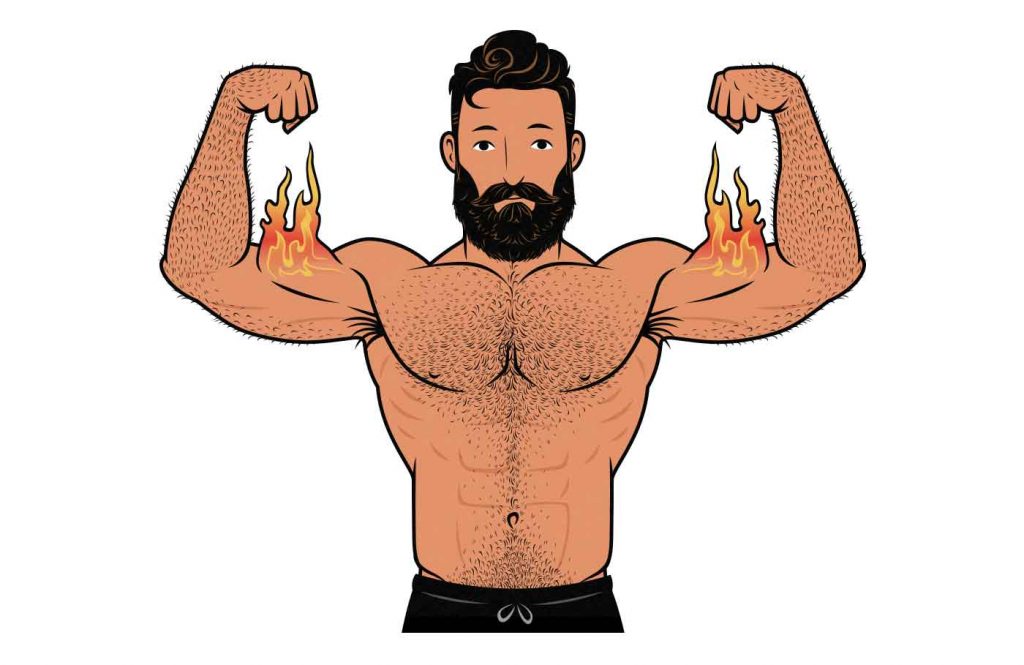
As we review Max Size, I don’t want to reveal too much of the workout program. I bought the program and I have it right here in front of me, but I’m intentionally being vague and giving away as few details as possible. That way if you want to learn more or try the program for yourself, you still need to buy it. I do want to talk about the training methods being used here, but I think I can do that without giving any of the magic away.
Max Size is the Athlean-X program for hardgainers who are looking to build muscle. Helping hardgainers bulk up is our area of expertise, so let’s take a look at the program and evaluate it for its ability to stimulate muscle growth.
The Max Size Workouts
Max Size starts with workouts that are built around two training methods. First, there’s German Volume Training for two compound barbell or dumbbell lifts (as is typical with German Volume Training). Then there are two finishers, training the same movements but with lighter variations or with our own bodyweight.
The workout routine is a body-part split, with each workout focusing on just two muscle groups. For instance, chest and back, quads and hamstrings, or biceps and triceps.
Is that an effective way to stimulate muscle growth? Let’s go into the details one by one.
German Volume Training (10×10)
The Max Size workout program is built around a method that Jeff calls XV-10, also known as German Volume Training (GVT). This method involves doing 10 sets of 10 repetitions (10×10) with 60% of your 1-rep max and 60 seconds of rest between sets. For example, the first workout starts off a 10×10 on the incline dumbbell bench press.
I’ve seen Jeff criticized by strength coaches for programming 10x10s with 70–80% of our 1-rep max. That weight is too heavy to get that many reps with, especially with such short rest periods. But that isn’t an issue here. He correctly recommends using 60% of our 1-rep max. This is standard German Volume Training.
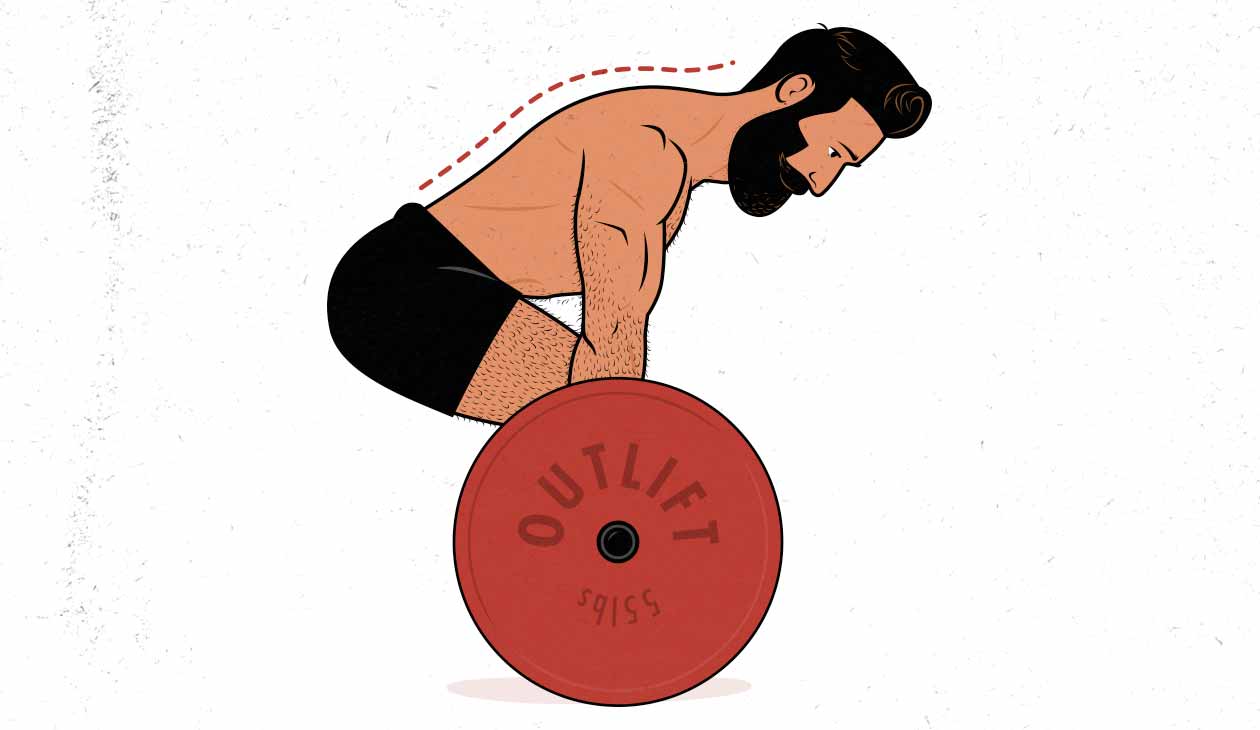
Doing 10 repetitions per set is great for stimulating muscle growth, and although most hypertrophy programs take advantage of longer rest periods, there’s nothing inherently wrong with using shorter rest periods. The general rule is that with shorter rest periods, we need more total sets, which is certainly the case here—we’re doing 10 sets per exercise.
The problem is that GVT isn’t an effective way to build muscle. It’s a high-volume approach to training that’s supposed to speed up muscle growth by ratcheting up the training volume. Or that’s the idea, anyway. There are two high-quality studies comparing GVT against traditional hypertrophy training for stimulating muscle growth, and both found that doing 4–6 sets per lift was enough to fully maximize muscle growth (study, study). Adding in those extra sets just increases fatigue, wear and tear, and makes the workouts needlessly difficult. As a result, the researchers concluded that GVT produced slightly worse results than traditional hypertrophy training.
The risk of injury, fatigue, and aches and pains would be lower with a more sensible amount of training volume, too. But to be fair, weight training is quite safe anyway, and if your joints started to bother you, you could always scale back the volume before it became a serious issue. The main disadvantage to GVT is that it makes the workouts excessively hard and leaves us needlessly fatigued without providing any benefit.
Also, consider that we need to factor in the opportunity cost. If we’re wasting all our time and energy doing extra sets on the bench press and row, we’re leaving less time and energy to invest into other exercises.
These findings aren’t controversial. German Volume Training isn’t widely used in strength training, bodybuilding, or athletics training, and the National Strength and Conditioning Association (NSCA) recommends against it. For more, we’ve got an article on German Volume Training, and a separate article on optimizing training volume for muscle growth.
German Volume Training is a poor way of stimulating muscle growth, and is by far the biggest flaw in this program. It’s not that it doesn’t work at all, it’s just that it doesn’t work very well. It’s needlessly hard and fatiguing and fails to stimulate as much muscle growth as far easier training routines.
The Finishers
After the German Volume Training come the “propain” finishers. As Jeff Cavaliere explains, he’s “pro pain,” and so these finishers are specifically designed to make our muscles burn with Hellfire. I’m not somebody who likes needlessly difficult training, but I love the puns and fiery branding. Anyway, these finishers work the same muscle groups as the earlier exercises. In the first workout, for example, we move from the bench press and barbell row to push-ups and inverted rows. Same movements, just lighter variations.
If we look at studies comparing the bench press and the push-up, we see that they train the same muscles and stimulate a near-identical amount of muscle growth (study, study). So stacking the two exercises one after the other is almost like making an arm day that has us doing 10 sets of barbell curls and then moving onto dumbbell curls. Problem is, we’ve already done too much volume for that movement. Why do more?
If it were me, after doing the bench press, I would choose an exercise for the muscles that weren’t properly stimulated by the first two exercises. For example, if we look at the bench press, we see that it’s a good lift for stimulating growth in our chests, not so good for stimulating growth in our triceps (study).

The reason our triceps see less growth is because the long heads of our triceps work at both the shoulder and elbow joints. When we’re pressing through the shoulder joint (shoulder extension), the long head of our triceps can’t contract very hard without pulling our elbows back (shoulder flexion). To balance out that disparity, then, we can include isolation lifts such as triceps extensions.
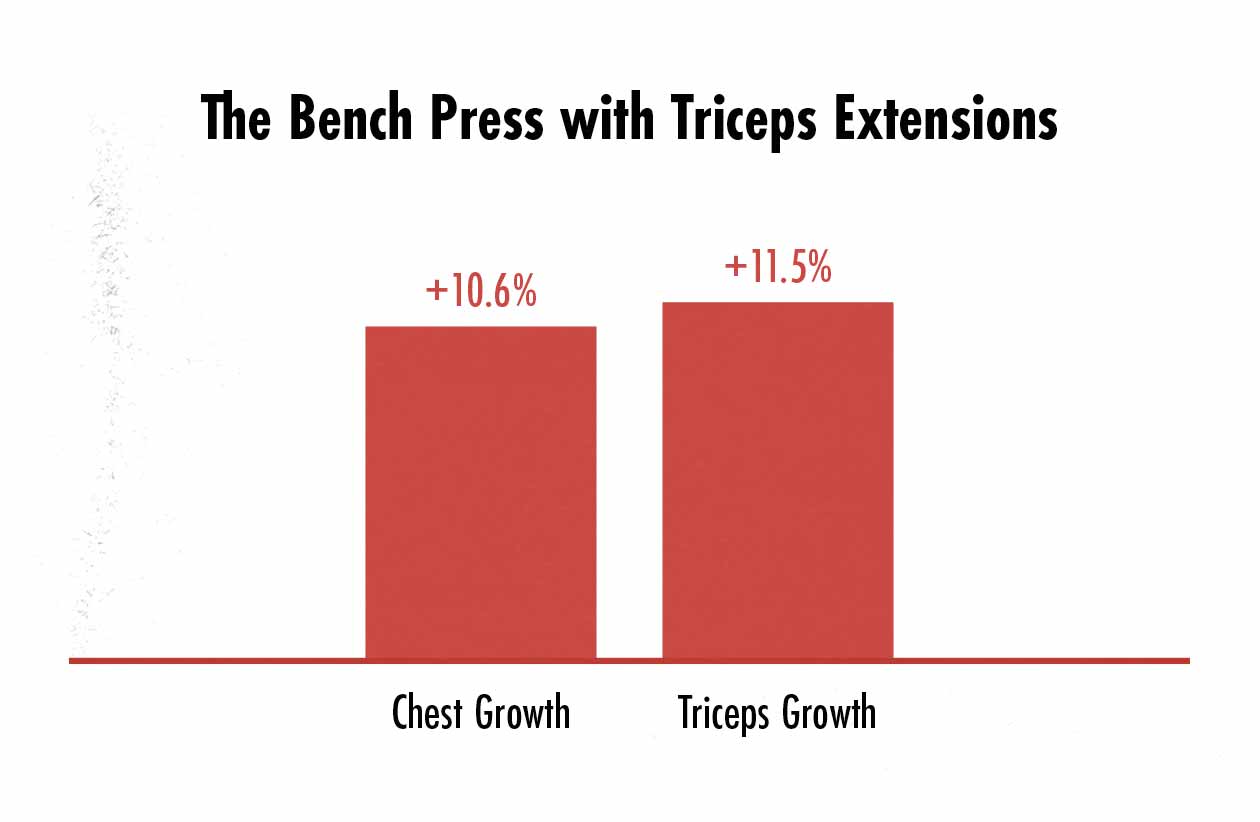
When we combine the bench press with triceps extensions, we get a robust and balanced amount of growth in both the chest and triceps. It’s a better combination than just doubling down on another pressing movement. And since there’s an arm-day later on in the week, this would give us a better training frequency for our arms.
Now, does this mean that these finishers are bad? No. They won’t make our muscles fall off or anything, and some people might really enjoy them. Doing multiple sets of push-ups to failure after being ravaged by German Volume Training is brutal, and I think the savageness of these Athlean-X programs is part of why people like them.
These finishers don’t do a great job of complementing the main compound lifts, especially since the volume on the compound lifts is already excessive. On the other hand, some people may enjoy how challenging they are.
The Body-Part Split
Max Size uses a training split that trains our chest and back, then our quads and hamstrings, then our biceps and triceps, and then our shoulders and traps. There’s also an “active recovery” workout that runs through a quick full-body circuit of isometric exercises (where the weight is held in place).
I don’t see any huge issues with this training split. Our muscles grow best when we train them at least 2–3 times per week, and this workout routine does that for most of our upper-body muscles. Our biceps and triceps get a bit of stimulation when we’re training our chests and backs. Similarly, our chests and backs get a bit of stimulation when we train our biceps and triceps. There’s just one leg workout per week, which isn’t ideal for leg growth, but I don’t know who would want to do 10×10 sets of squats twice per week, so in a way, that’s a blessing.
This body-part split probably isn’t the most efficient way of training, and I think another training split might do an even better job of stimulating muscle growth, but I think it’s reasonable, and I bet a lot of lanky-limbed hardgainers enjoy having a dedicated arm day like this one.
Exercise Selection
One of the most important parts of building a good hypertrophy program is choosing lifts that are good for stimulating muscle growth and that we can do properly. Right in the very first video, Jeff Cavaliere explains that this program is good for helping beginners who are struggling to put on their first 15–20 pounds of muscle and for advanced lifters. That creates a bit of a problem. As you can imagine, the lifts that are best for an advanced lifter may not be ideal for someone who hasn’t mastered their lifting technique yet.
If this workout program is for newer lifters who aren’t training with an in-person coach, I think these exercises might be needlessly complicated. The more complicated a lift is, the harder it is to stimulate muscle growth. It may also—debatably—increase our risk of injury. I’d much rather see novice lifters starting with squat, deadlift, and row variations that are easier to learn
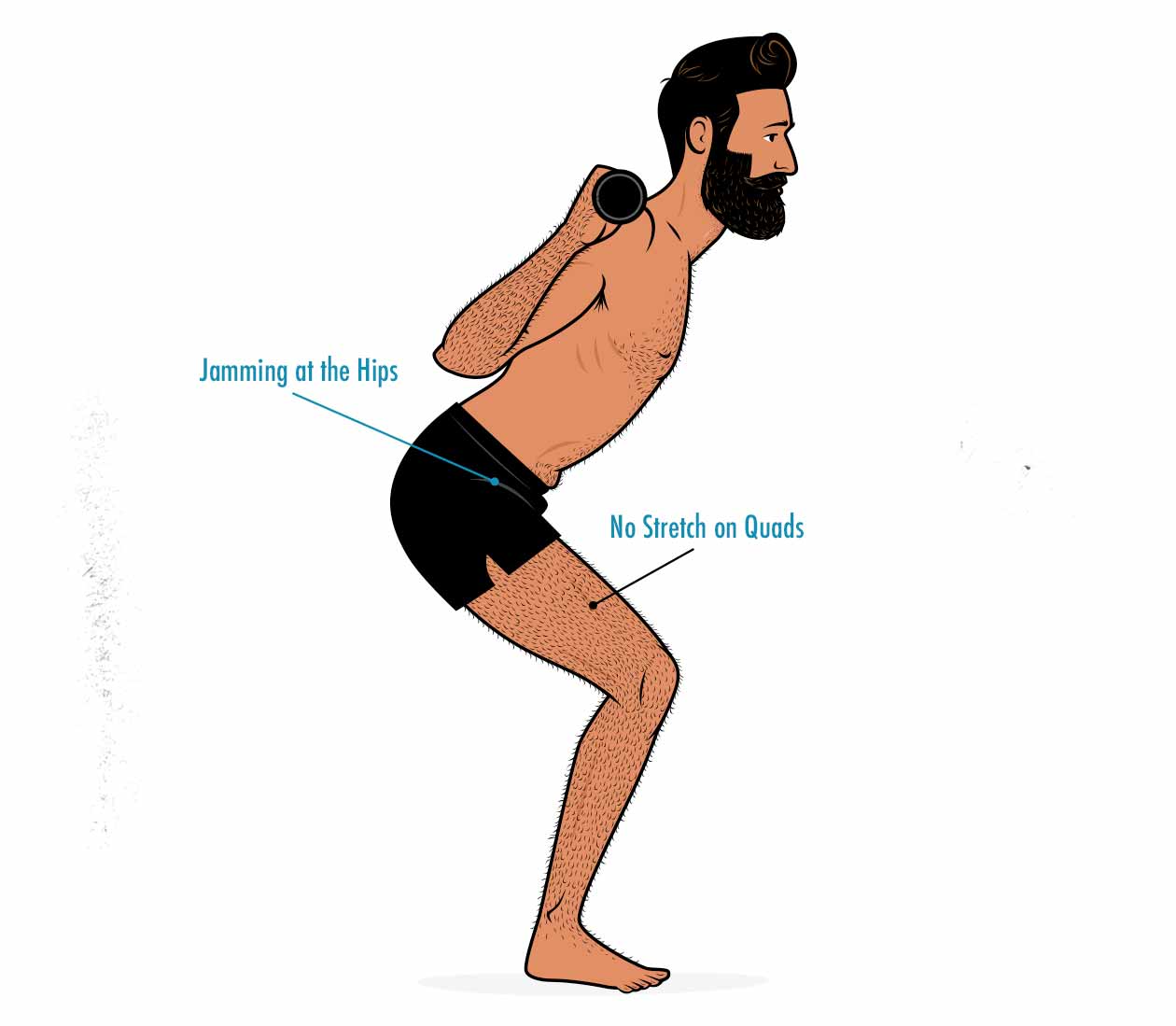
For instance, a lot of beginners have trouble doing back squats to a decent depth without jamming at their hips, which can prevent them from working their quads through a deep range of motion, and thus makes the lift worse at stimulating muscle growth. Using a partial range of motion also means that we need to load up heavier weights in order to challenge ourselves, putting extra stress on our knees. That’s not necessarily the end of the world, but it’s not the most efficient way to stimulate muscle growth, and a lot of beginners have trouble with it.
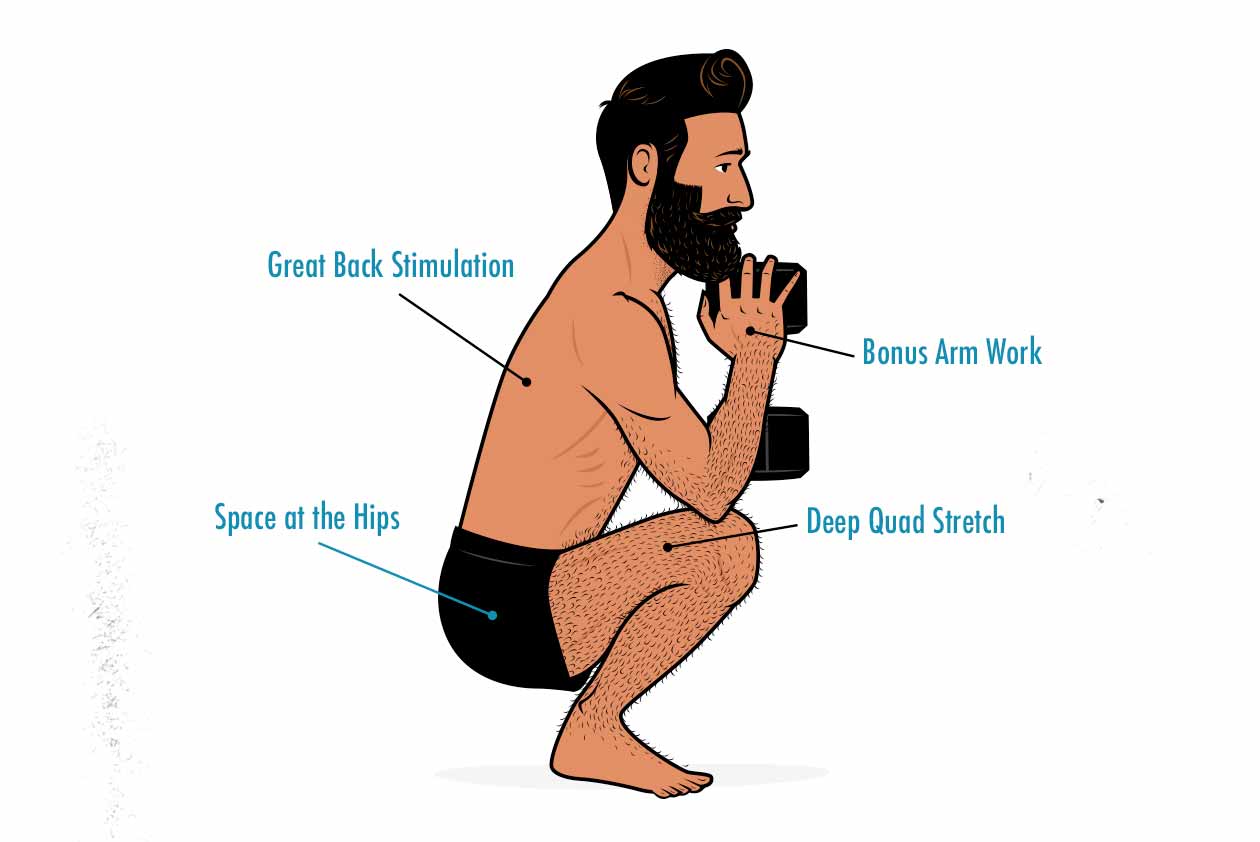
Instead of starting with a barbell back squat, why not something like a goblet squat? It’s much easier to learn, shrinking the learning curve and allowing us to stimulate muscle growth right from our very first workout. Goblet squats are also easier to set up, stimulate more growth in our upper backs, and they teach us how to squat through a deeper range of motion. They’re also quite a bit easier on our knees. The only downside is that once we become very strong, we need to lift something heavier than dumbbells. But for a skinny beginner, they won’t be able to do 10 reps with the heaviest dumbbell anyway, and so that’s not an issue.
Mind you, Jeff also mentioned that this program can be used by advanced lifters. And in that case, I think the exercise selection here is fairly reasonable. Lots of squats, deadlifts, bench presses, bent-over barbell rows, chin-ups, skull crushers, barbell curls, and so on. As someone who already knows how to lift weights, and who’s spent some time strengthening his lower back, these are the sorts of lifts that I enjoy.
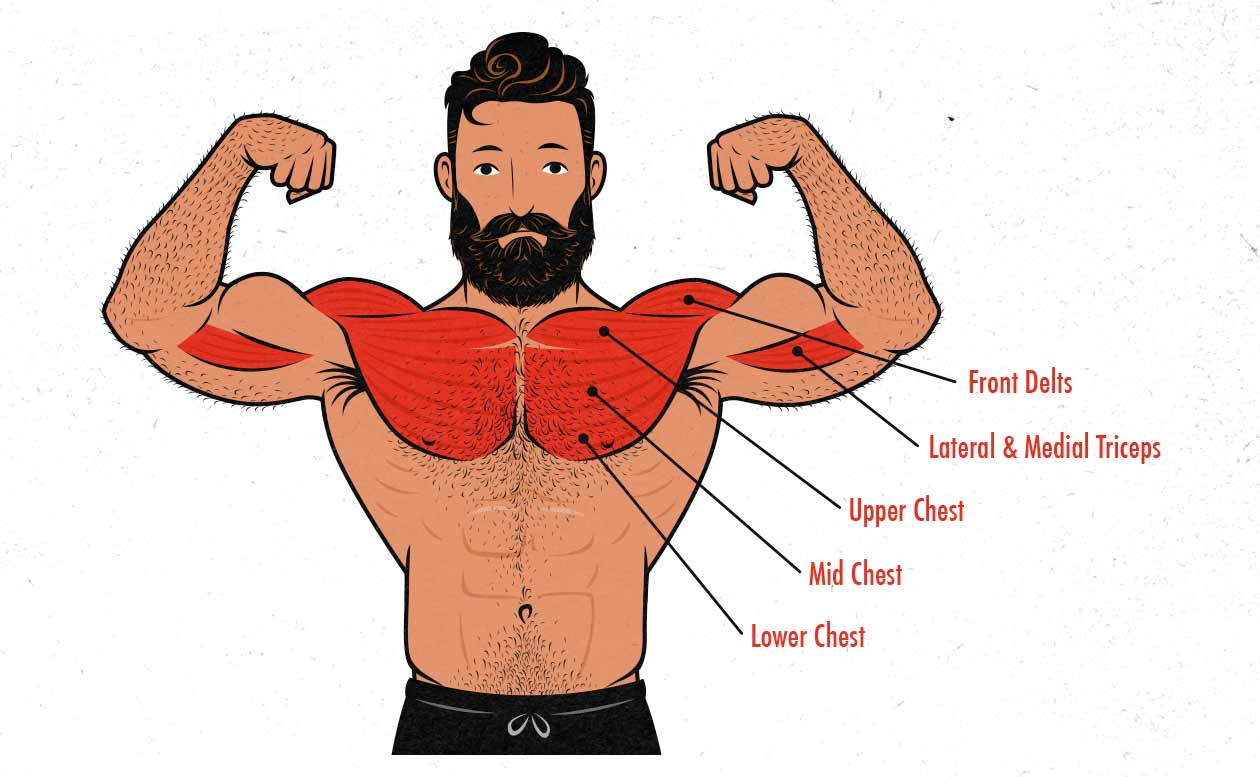
Could the exercise selection be better for an experienced lifter? Maybe. For example, I think the flat bench press is a better lift than the incline bench press for building a big and powerful chest. It allows the chest and shoulders to be worked harder at longer muscle lengths, which can improve muscle growth. It also works our mid-chests harder, which is where most of our chest size comes from. But that’s not a big deal. Both lifts are great.
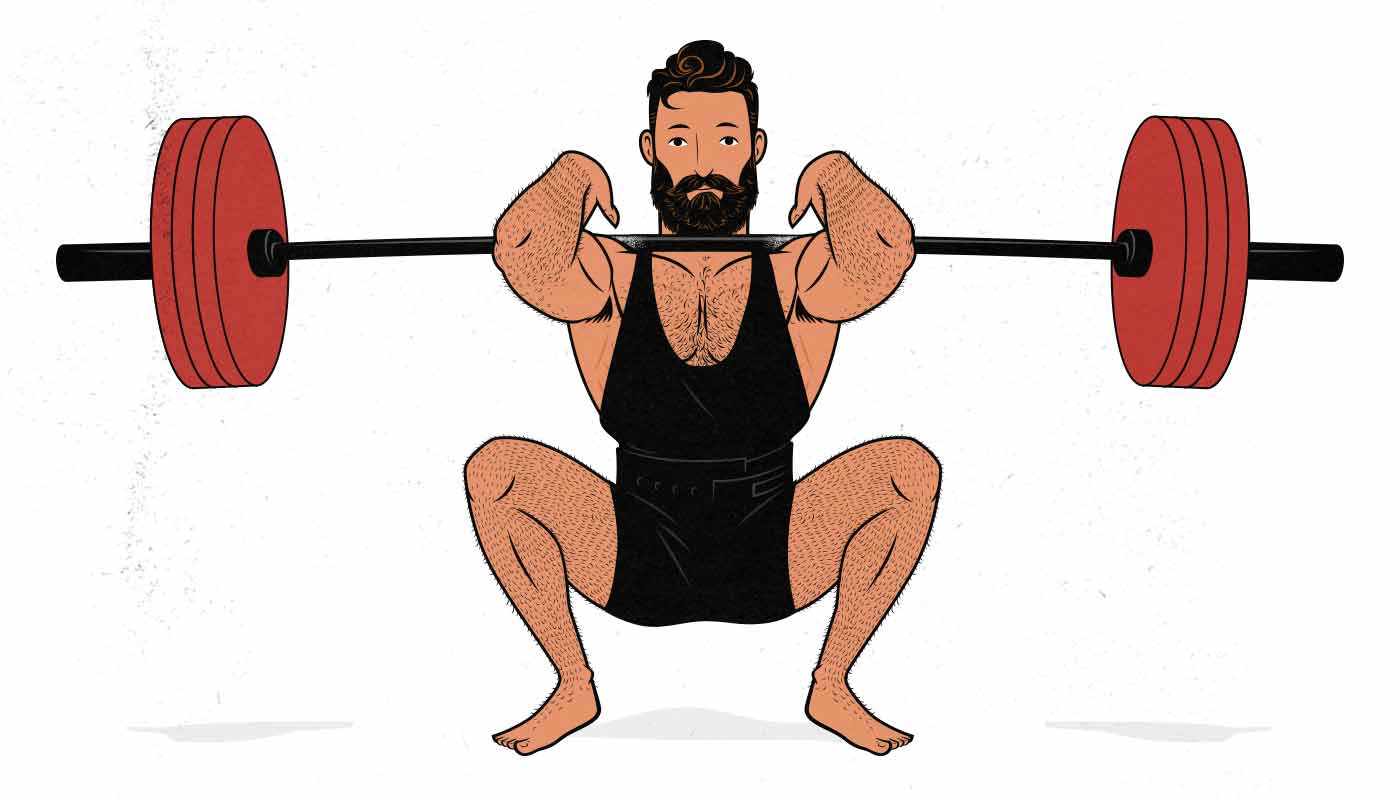
Similarly, I might choose front squats instead of back squats. They’re a bit easier on our joints, a bit safer, they bulk up our upper backs, and they usually allow for a deeper range of motion. Jeff Cavaliere, on the other hand, teaches back squats using a partial range of motion, which isn’t ideal, but it’s not the end of the world, either.
Overall, I don’t think this exercise selection is appropriate for most beginners who are still struggling to gain their first 15–20 pounds of muscle. For a seasoned lifter, though, these lifts are pretty good.
Partial Range of Motion
As mentioned above, Jeff Cavaliere recommends doing partials on the squat and bench press, lowering the weights down to pins instead of bringing them to full depth. He says that this makes the lift safer, and to be fair, there are certainly people who benefit from restricting the range of motion of their lifts. But it also creates some problems:
- When we do partials, we don’t get a stretch on our muscles, which reduces the growth stimulus by quite a lot. From a hypertrophy perspective, that’s the most important part of the lift.
- Doing partials forces us to use heavier weights to keep the lifts challenging, which tends to put more wear and tear on our bodies, make our workouts more fatiguing, and make it harder to recover between sessions.
- Doing partials means that we don’t develop strength in the bottom positions. From a general strength perspective, I don’t think that makes much sense. It’s better to develop strength all through the range of motion.
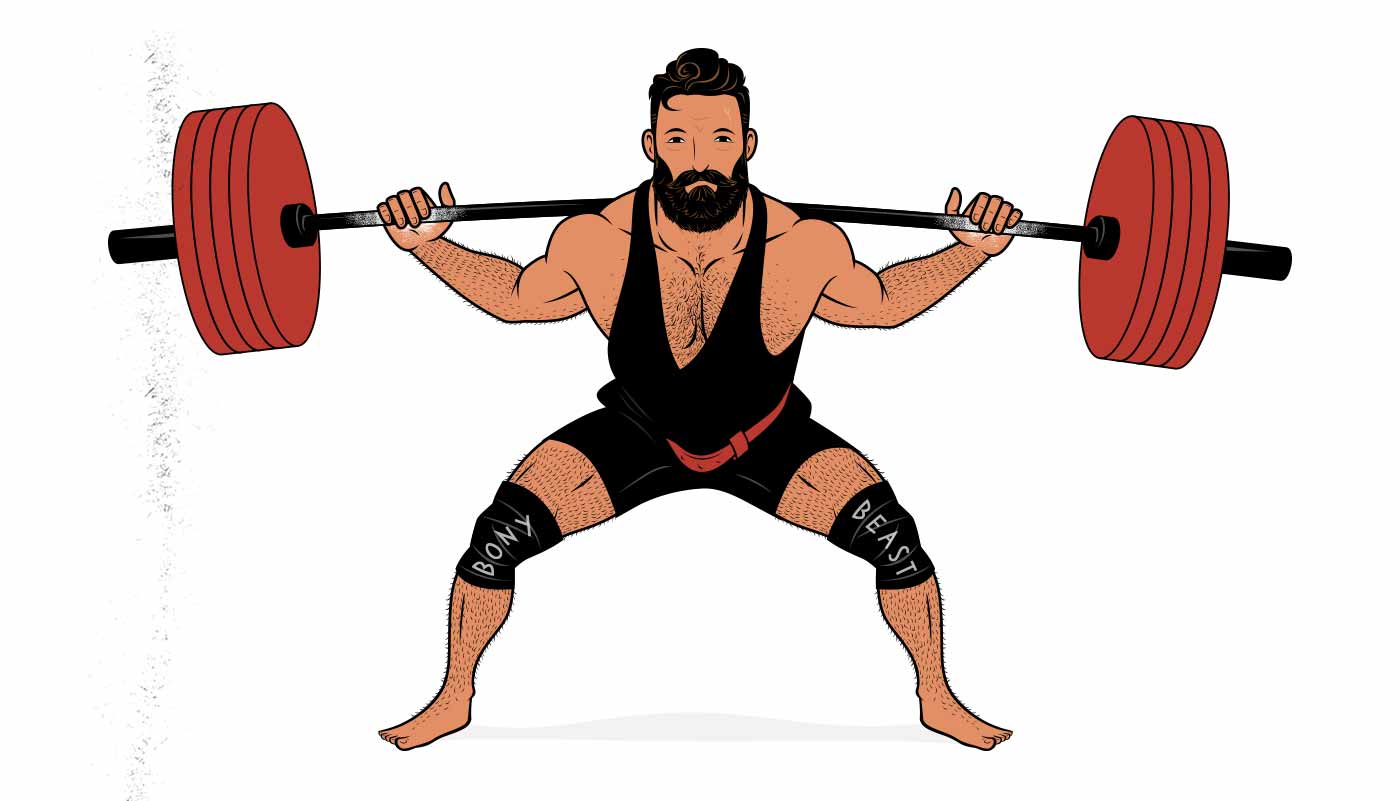
Some people might need to restrict their range of motion, and that’s perfectly fine, but for the people who can manage it, I think it’s better to get a deep stretch on our muscles at the bottom of our lifts. We develop better general strength, our workouts are easier to recover from, and we can stimulate more muscle growth.
For the people who aren’t able to lift with a large range of motion on the back squat and bench press yet, instead of recommending partials, I’d choose different lifts. For example, goblet squats and front squats are amazing for teaching people how to squat deeper. And as they learn, they’re still able to train their quads through a deep range of motion, stimulating a robust amount of muscle growth as they improve their mobility.
On a similar note, Jeff recommends training our muscles at various points of the range of motion with separate lifts. One lift to stimulate our muscles in a stretched position, another for the mid-range, and another for the contracted position. At the moment, the evidence points in the other direction.

If we look at the research, we see that training our muscles at longer muscle lengths stimulates almost three times as much muscle growth (meta-analysis). Plus, when we’re emphasizing different parts of the range of motion, we’re training the same muscle fibres. It’s not that different muscle fibres or heads are being stimulated.
For example, if we look at a recent study on hamstring training, we see that lifts that train our hamstrings at longer muscle lengths stimulate more growth than lifts that train our hamstrings at shorter muscle lengths. There doesn’t seem to be any benefit to doing both, it’s just that deeper is better. If we apply that same logic to our chests, then if we use lifts that train our chests in a stretched position, such as a full bench press, dip, push-up, or dumbbell fly, then there’s no need to do lifts that emphasize the contracted position, such as a cable crossover.
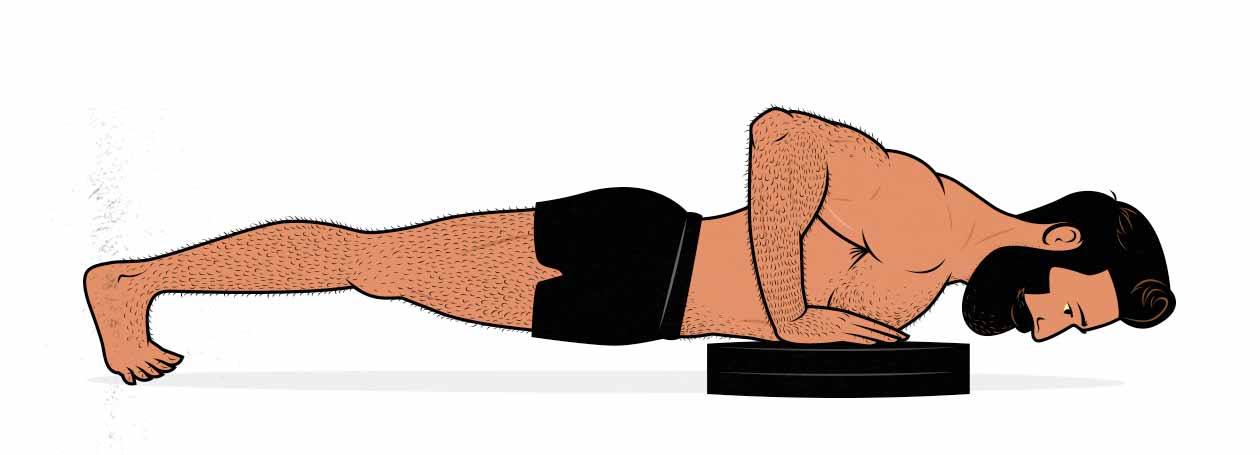
And besides, if we use lifts that work our muscles in a deep stretch—such as a full range-of-motion bench press or squat—then we’re training our muscles at longer muscle lengths at the bottom and at shorter muscle lengths at the top. We get the best of both worlds simply by trying to sink deep into our lifts.
With that said, any lift that challenges our muscles will stimulate at least some muscle growth, at least until we’ve reached a volume threshold where extra work just increases our recovery demands. I just think there’s a more efficient and effective way to gain muscle size and strength.
Training with a deeper range of motions stimulates more muscle growth and gives our lifts a better stimulus-to-fatigue ratio. We get faster muscle growth, less wear and tear, and we recover more easily. Not everyone can lift with a deep range of motion on every lift, but most people can find lifts that allow them to improve their mobility and train with a good range of motion.
Isometrics
This program features a lot of isometrics. I don’t think that’s a problem, necessarily, but as a general rule, lifting through a range of motion stimulates more muscle growth than holding a weight in place. Isometrics aren’t bad, though. They have their uses. Especially when they’re done at longer muscle lengths. So it’s not wrong for a hypertrophy training program to include some. It’s just that this program uses a lot of isometrics.
This program uses a lot of isometrics, which may not be the best use of our time or energy.
Challenges
When I was a skinny guy who was desperate to bulk up, I just wanted to build muscle. I didn’t want haphazard metabolic conditioning workouts sprinkled into my hypertrophy program. And if I did want to do that, I’d want them to be a part of some overall system, not just random challenges at the end of each month. For example, when I was first bulking up, I started by doing pure hypertrophy training. But after a few months of that, I added in two 20-minute cardio workouts every week to improve my overall fitness. Every workout, I would try to improve my performance. There was progressive overload built into my training, even for cardio. It wasn’t just randomly thrown in.
But that doesn’t mean that these challenges are bad. In fact, they’re probably quite good for our general health. So no issue there. It’s just not what I would have wanted.
There are random challenges tacked onto the end of each training phase. Jeff Cavaliere is a big advocate of making things as painful as possible, and these are designed to be brutally hard. Will that increase muscle growth? Not really, no. But some people enjoy being challenged just for the sake of the challenge.
Progression
The Max Size workout program starts off with 10 sets of 10 repetitions right from the very first workout. The problem is, when we first start a new training program, we haven’t adapted to it yet, and so our muscles are still fairly sensitive to muscle damage. We aren’t tough yet. This is true of almost everyone, but it’s especially true with novices and people who are detrained.
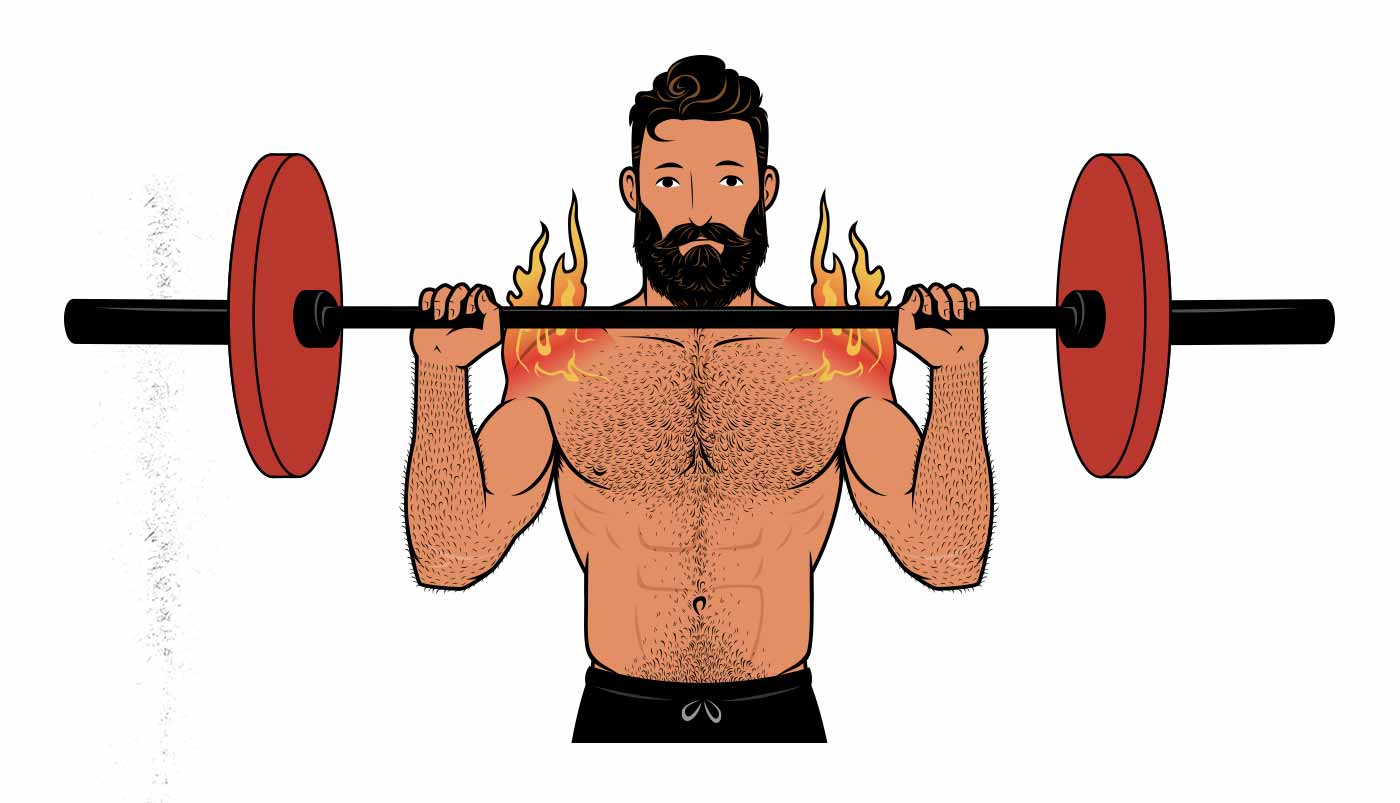
That means that if we start with an extremely high training volume, we cause excessive muscle damage, which can reduce muscle growth. Plus, that high training volume will also cause crippling muscle soreness, impairing our ability to do our next workout properly, and thus further reducing our muscle growth.
If someone wanted to experiment with German Volume Training, a more sensible approach would be to start by doing 2–3 sets per exercise and gradually working their way up week by week. Most people cap out at around 6 sets per exercise (which is why German Volume Training is usually a bad idea), but some people are outliers that can benefit from higher training volumes. Those outliers could continue adding sets all the way up to 10 sets per exercise. I still don’t think that’s ideal, but it would be a more reasonable way to progress into classic German Volume Training.
As we progress through the Max Size workout routine, the rep ranges and exercise order are shuffled from workout to workout, and the training methods are changed from phase to phase. Some people find that way of training more interesting, but it also makes it harder to measure our progress to see if we need to adjust our training. Mind you, it’s not that varying our workouts like this impairs muscle growth. In fact, there’s research showing that varied workouts stimulate muscle growth equally well as if we kept the variables more consistent (study). But there’s no advantage to it. It just makes our progress harder to gauge.
There are also some peculiar methods being used here, such as doing concentric-only training one day and then doing eccentric-only training the next day. That seems like a very inefficient way to stimulate muscle growth, and I’m not sure there’s any research to support it. I suspect it would be more effective to keep the phases more similar to one another but to put more emphasis on progressive overload.
There’s no emphasis on progression or progressive overload in this program. It starts off way too intense right out of the gate and then variables are shuffled around from week to week to keep things interesting. That’s not the best way to stimulate muscle growth, but it can work in a pinch.
The Max Size Diet
Some of Athlean-X’s advice about how to eat a bulking diet is great. The meal plan includes some perfectly good recipes and he recommends swapping out the things we don’t like for things that we do like. When we’re struggling to gain weight, that’s crucial. Better to eat a diet that we enjoy, can afford, that fits our schedule, and that we can digest well. He also stresses that we don’t need to swap out all of our meals for the ones he provides and that the best we can do is good enough—that getting things 90% right is fine. I love that.
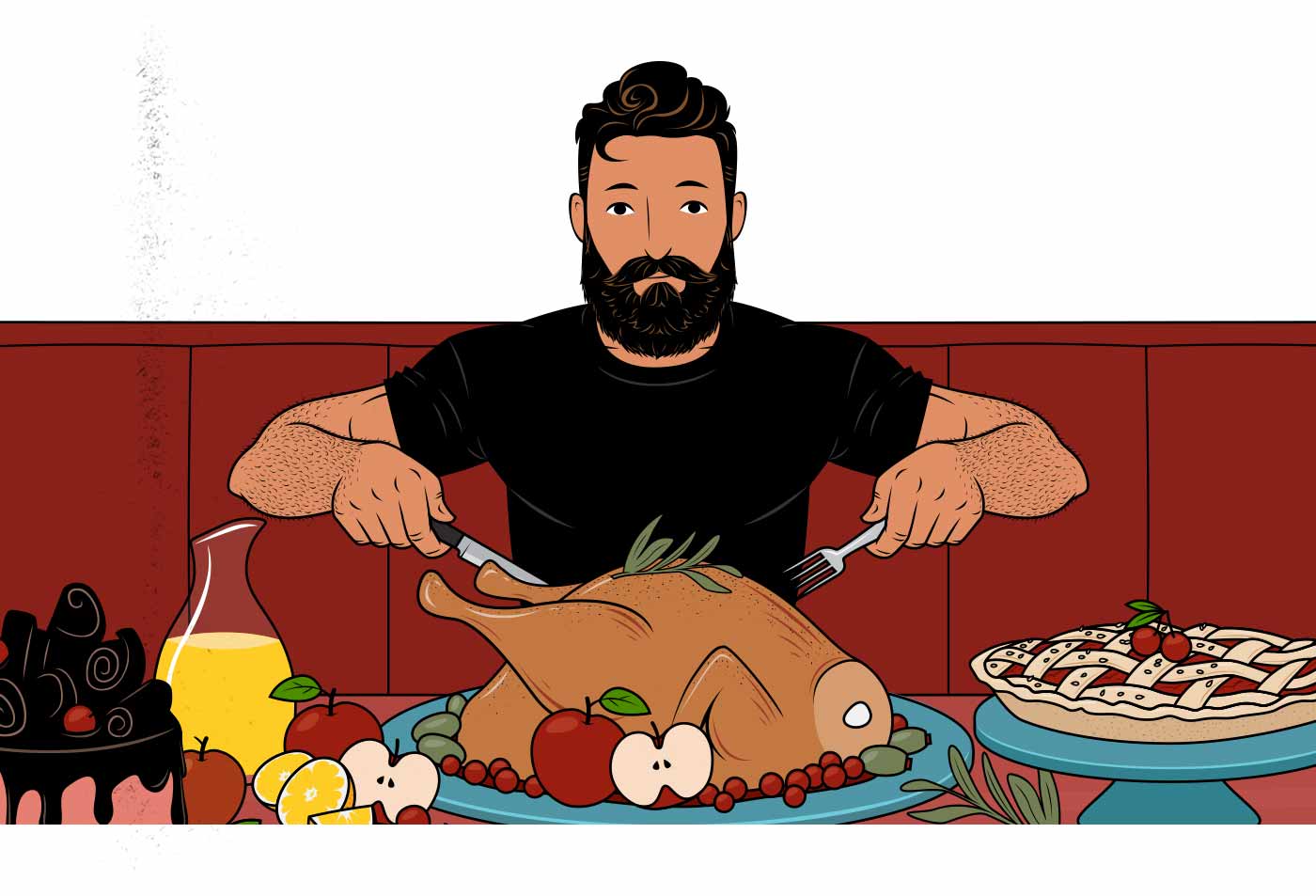
Some of the diet advice is more questionable. He subscribes to the old bodybuilder method of eating every 2.5–3 hours to “keep your muscle-building factory in full operation” and to “keep your blood sugar stable.” Eating at least three meals per day can improve our ability to build muscle, and there’s nothing wrong with eating more often than that, but we don’t need to eat every 2.5–3 hours, and our blood sugar won’t be an issue regardless of our meal schedule. So there’s a bit of fearmongering there, perhaps. But with that said, some hardgainers find it helpful to eat lots of meals and snacks. We often have smaller stomachs than the average guy, and so eating smaller meals more frequently makes it easier to eat enough calories to gain weight. So this is by no means a bad way to bulk, it’s just not the only way to bulk.
There’s some nonsense in here, too. Jeff Cavaliere says that sweets “do nothing for helping your muscles repair themselves and grow larger.” He also says that they don’t give us useable energy. That’s just flat wrong. Simple carbs are easily converted into energy, and so most athletes eat quite a bit of sugar or starch. We don’t need to eat any processed sugar, but it’s unlikely to harm our ability to build muscle quickly and leanly, and sugar absolutely contains energy that our bodies can use. Our muscles are literally full of sugar. Muscle glycogen is sugar. Our muscles are powered by sugar.
Some advice is missing, too. He recommends taking protein supplements, but he doesn’t give a daily protein target. Most research shows that we can maximize muscle growth with 0.8–1 gram of protein per pound bodyweight we day. That’s useful information to know. Most people don’t eat that much protein, and so when we first start bulking, it can really help to track protein intake for a few days to make sure that we’re eating enough of it.
The main problem, though, is that he makes no mention of adjusting calorie intake based on whether we’re gaining weight or not. That’s a recipe for disaster when working with hardgainers who are struggling to build muscle. To build an appreciable amount of muscle as a skinny guy, we need to eat in a calorie surplus. That’s easier said than done, and so to make sure that we’re succeeding at that goal, we need to weigh ourselves every week and adjust our calorie intake accordingly. If we aren’t steadily gaining weight, we need to increase our calorie intake.
This diet contains some bro-science and incorrect information, and it might make people a bit fearful about eating sugar or sweets, but I think it’s a reasonable muscle-building diet if people already know how to eat enough protein, eat enough calories, and gain weight steadily on the scale each week.
Sleep Recommendations
Sleep is an underrated aspect of building muscle. By improving our sleep, we can build muscle faster and gain less fat while doing it (study). So I like how Jeff Cavaliere mentions sleep in this program, saying that you should “aim for 7 hours of sleep a night to give your body the best ability to recuperate and restore your energy levels.”

We generally recommend a little more sleep than that, but his advice lines up the recommendations of the American Academy of Sleep Medicine (source), so no problem there. It’s possible to go much deeper into improving our sleep, and given how important it is when trying to build muscle quickly and leanly, I would have wanted more than a single sentence on it. But his advice is solid, and I appreciate that he mentions it at all.
I think the sleep and overall lifestyle recommendations in this program could be more detailed. On the other hand, not every bulking program needs to have everything in it. There’s only so much it can include.
Tracking and Progress
There’s no mention here of taking progress photos, measuring our muscles, or evaluating our progress in any way. One of the most essential parts of making a good muscle-building transformation, especially if you’re trying to do it in a short period of time, is to measure your progress and adjust accordingly.
If a week goes by and you haven’t gained weight, you need to increase your calorie intake. If you complete a phase of the program and your muscles haven’t grown bigger, you need to adjust something. Or what if you notice that you’re gaining weight and getting bigger but you’re also gaining too much fat? What then? Who knows. It doesn’t say.
If someone is a hardgainer who’s having trouble building muscle, I’m not confident that this program will give them the toolkit they need to ensure steady and consistent progress as they go through the program.
The Verdict
The Athlean-X Max Size workout program by Jeff Cavaliere promises muscle growth. For people who know to eat enough calories and protein, it will deliver on that promise. The workouts might not be ideal, but they’re certainly rigorous enough to provoke muscle growth.
- The program is built on a foundation of compound free-weight lifts, such as the squat, incline bench press, deadlift, and barbell row.
- The rep ranges are reasonable for stimulating muscle growth.
- Short rest times can be okay for stimulating muscle growth.
- The training split trains our upper-body muscles twice per week.

However, I think it’s important to compare this program against the industry standard, and it’s not as good as a traditional hypertrophy program. Here’s why:
- This program uses German Volume Training (10 sets of 10 repetitions), which has fared quite poorly in the research and isn’t advised for building muscle. Traditional set and rep schemes (such as 4 sets of 10) are not only quicker to do, but they’re also easier to recover from and produce better results.
- The exercise combinations could be better. For example, instead of doing 10 sets of the bench press followed by several sets of push-ups, it would probably be better to do 3–6 sets of the bench press followed by some triceps extensions (such as skull crushers).
- There’s no emphasis on progressive overload from week to week, or even from phase to phase. There’s a bigger emphasis on variety than progression. That doesn’t ruin a program, but it does make it harder to gauge if we’re making progress or not.
- Jeff Cavaliere says that he’s intentionally promoting pain with these workouts. They’re designed specifically to be difficult. Why not design them to be effective instead?
Overall, there’s too much emphasis on making the workouts hard, too little emphasis on stimulating muscle growth, the lifts aren’t good for novice lifters, and the training is too haphazard. But to put this into context, the very first bulking routine I ever did wasn’t very good. It was a typical push/pull/legs bodybuilding routine that was made up entirely of 3 sets of 8 repetitions on a wide variety of lifts. That’s not ideal, but because I was new to lifting weights, it was enough to stimulate quite a lot of muscle growth. I was able to gain twenty pounds during my first three months of lifting. I don’t think Max Size is as good as that bodybuilding program, given that it strays so far from what has proven to be effective, but I think the effect would be similar. These workouts are enough to stimulate muscle growth.
If you’re a new lifter, the most important thing is that you start lifting. If this program gets you motivated to train, absolutely buy it. Even though it may not be the best hypertrophy program for a skinny novice lifter, we’re nitpicking here. If you combine these workouts with a good bulking diet and lifestyle, you’ll finish the program bigger than when you started it.




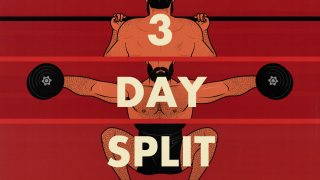
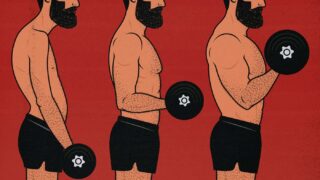
Hey guys!
In my opinion, I really think you should keep on analyzing programs like this. It’s very helpful for all expert or non-experts lifters. Also, it helps us to save a lot of money lol. Anyway, just want to let you know that your articles are awesome, seriously. Congrats for the good work!
Thank you so much, Guilherme!
I worry that by saying some critical things about a program it might discourage people from having faith in the program they’ve decided to follow. But the truth is, most workout routines that are designed to stimulate muscle growth, even if they aren’t perfect, are enough to provoke growth. Combine a halfway decent workout routine with a good bulking diet and people do grow. And then from there, people can continue to learn more and improve their workout routines.
But if you guys really like these reviews, we can write more. Could be an interesting way to cover the principles of hypertrophy training 🙂
Shane
Amazing review as always. B2Ber here.
Can you do a review of THENX? I love calisthenics and they are challenging but look cool when you can do them.
After doing b2b for over 6 years when corona took away my gym it was hard to do body routine workouts from what I learned in b2b (not enough variety got me bored).
This pushed me into no equipment workouts with calisthenics. They are fun but hard to progress in. My cardio was lacking as well from getting too cushy in my gym routines. After 3 months I am slowly getting better at these new routines with calisthenics but I think it might be very challenging for skinny guys with no previous lifting experience.
My 15-year-old nephew who I was training at the gym in the b2b ways, loved the b2b training but gave up after 2 sessions of calisthenics.
What’s your take on it?
Adan – fellow b2ber
Hey Adan, thank you! I’m really glad you liked it 🙂
Yeah, I can take a look to see if he has any bulking programs. If so, I could probably review it. In the meantime, we’ve got an article on bodyweight hypertrophy training. It gives a framework for how to gain muscle size with calisthenics. You could take those principles and apply them to the exercises that ThenX teaches in his videos.
Personally, I find it much easier and more enjoyable to stimulate muscle growth by lifting weights. But calisthenics can work! The program just needs to be built around the same hypertrophy principles as any other bulking program. We cover all of that in the article 🙂
Shane,
This review was very helpful and I’d love to see more like it! I started my strength training with you guys several years back and have always appreciated your thorough and evidence-based approach – I feel like I know what you guys value in a program. I’m always interested in looking at various other programs out there and I’d love to hear your thoughts on other programs as I trust and value your opinions and general approach to evaluating information. Thanks for the info!
Thank you so much, Sean! That really means a lot 🙂
Thank you very much. Your review was fair and well thought out. I am at the beginning of my journey and your review educated me and will Help me make better decisions going forward.
Tim
My pleasure, Tim, I’m really glad it was helpful. Good luck on your journey! 🙂
This was a great article, as a skinny guy who is trying to build muscle, I stumbled upon their channel, but was a bit confused by their routines, but this article clarified the fact that a short and simple progressive overload routine can be much more effective.
Hey Abdel, thank you! I’m really glad it helped.
Yeah, you can accomplish a lot with good exercise selection, three full-body workouts per week (or whatever split/schedule you prefer), moderate rep ranges and rest times, and stopping just shy of failure. And then from there, the emphasis is on outlifting yourself every workout, always aiming to add a little weight, squeeze out an extra rep, or add a set. The simpler that can be, the better 🙂
Really enjoyed reading! Thanks!
If you do another program, I think it’d be especially interesting to see a program designed for a different audience (e. g., athletes, swimmers, runners, movie stars), that way you can incorporate new information and ideas that don’t make it into the blog as often. It’d be super interesting, at least to me. That said, I appreciate what you said about sticking to your main experience in muscle building for hard gainers.
But yea, really awesome discussion here. Thanks for writing!
My pleasure, Aaron!
Marco cut his teeth as a strength coach by helping college, pro, and Olympic athletes build muscle. That’s something Marco is quite good at, especially with football and rugby. Most of our audience is more interested in building muscle, gaining strength, and improving their health and appearance, but we could make some content about training for athleticism, too 🙂
That’d be really cool!
I’ve been doing a lot more running lately (walk-running actually), especially since quarantine. If you guys made more blog or official paid content on cardio and athleticism I’d eat it up!! The muscle and health (M&H) issues on these kinds of things were great!
What program would you recommend in that case for hardgainers?
That’s a surprisingly tricky question. When I was a skinny guy who was trying to bulk up, I was really frustrated by the lack of options that were available. That’s why we decided to get into this industry. Then, a couple of years after we made our program, Precision Nutrition re-launched their Scrawny to Brawny program. It was run by John Berardi, PhD, and led by Nate Green, both of whom are great. But after a couple of years, they closed it down to focus on helping overweight people. And I get that. Over half the population in developed countries is overweight or obese. Only around 2.5% of people are underweight. It’s a much bigger market.
It gets more complicated because almost all of the best strength coaches make content for advanced lifters. At the beginning of the article, I mentioned Eric Helms’ Training and Nutrition Pyramids, Greg Nuckols’ Average to Savage, and Eric Cressey’s programs (such as Show and Go). Those are all great. I’ve bought them all, thoroughly looked through them. But they’re not specifically for hardgainers and they’re not for novices.
We’ve got our Bony to Beastly Bulking Program for hardgainers. I realize we’re biased, though, and I suspect there are other great hardgainer programs out there, too. If we keep doing these reviews, I’m sure we’ll find some.
Firstly, I really enjoyed reading this article! I love your stuff on the B2B site as well. I would be interested in more program reviews as I really trust the opinions of you guys. And to echo Aaron’s comment, I would be really interested in articles on athleticism, including program reviews. I play tennis and soccer, and I am often reluctant to bulk (I am a skinny guy who wants to add some mass) because I feel like hard training makes me too sore to enjoy my sports or my sports make me too tired to give my all to my training. I feel like my athleticism could go up a notch if I gained some size and strength though.
Thank you, Nick!
Yeah, I hear ya. That’s one of the problems with programs that focus on tiring us out and making us sore. It doesn’t improve muscle growth (at least not in the case of German Volume Training) and it can really cripple people for a few days after each workout.
You might prefer doing a full-body program where you train each muscle a few times per week with a lower volume. You won’t ever get as sore or tired, and your performance won’t ever drop by as much, especially if you ease into it with a “deload” or “ramp” week, gradually increasing the volume from there. Weight training doesn’t just make us stronger, it also makes us tougher, so the fatigue and soreness shouldn’t be a longterm problem. Just need to ease into it gradually and use a sensible workout program.
Thanks for the review, very helpful!
I was just wondering if there is an optimal workout duration in general for bulking? I‘m asking because I just started the Outlift routine and it seems very short to me (I‘m usually done in 20-30mins), while this program here seems to be a bit longer.
Hey Nico, it depends on how dense the training is, how many days per week you’re training, how much volume you need as an individual, and how strong vs fit you are. Someone who’s quite fit but not very strong yet can blast through workouts quickly, whereas someone who’s quite strong and not all that fit yet will be winded by their workouts and need to rest longer. Plus, people can only train for so long before they get too fatigued to do good work.
With Outlift, the first week of each phase is a “ramp” or “deload” week that eases people into the phase. The volume is at the lower end of the ideal range. It’s just a couple of sets per exercise. The first phase also uses shorter rest times than the others, making it denser. As you get deeper into the program, you’ll see that the volume climbs and the workouts get a bit longer.
Longer isn’t necessarily better. It can be, though, depending on the circumstances.
Hi Shane. Personally I don’t think it feels quite right that you review competitors’ programs (even if you are saying nice things about them). I think if you’re evaluating generic methods such as German Volume Training that’s fine, but not actual programs from other providers.
I’m a b2b customer, and I love the in-depth articles you guys do on specific aspects of training, diet, health & science related to your programs. These articles give me an extra boost of motivation every time they arrive in my inbox, and this is what I’d love to see more of.
I hear ya, Danny. We’ve avoided writing articles like this for a full decade now.
Our mission is to help skinny guys bulk up, right? So from that perspective, it makes sense to be as open and honest as possible. If a program has problems, talk about it. Not to discourage people from trying the programs, but just to arm people with more information. In this case, maybe simply telling people that if they find this too hard, it’s not that they’re too weak or lazy to build muscle, it’s just that this program is specifically designed to be brutally hard. Or if they aren’t gaining weight, it’s not a problem with their genetics or metabolism, it’s just that they need to combine this program with a calorie surplus. We might be able to help skinny guys avoid failure and frustration that way.
It gets even trickier because Max/Size isn’t advertised as a German Volume Training program. And inside the program, Jeff Cavaliere calls it XV-10 training. So even after someone buys the program, they won’t know how to look up whether its effective or not. If they find it brutally challenging, they might assume that to get results, we need to suffer. If it leaves them fatigued, they might assume that weight training means being perpetually tired. But that’s not true.
I had a number of failed bulking attempts before I finally succeeded in gaining weight. If someone could have pointed me in the right direction sooner, I would have been very grateful. In fact, I was just about to start a German Volume Training program when Marco advised me against it and gave me a better program instead. That’s why this one hits close to home. I really appreciated his help back when I was still so new to this. It feels right to extend that same word of warning to other skinny guys, even if I don’t know them personally.
But then on the other hand, yeah, it doesn’t feel right. I totally agree with you. I had a long conversation with my wife about this the day before publishing this article. I was torn. But then if I imagine myself back when I was skinny and frustrated, I would have appreciated this. It would have really helped me. And I suspect it might help a lot of other skinny guys who are just getting started.
I think it might still be helpful to review Starting Strength and StrongLifts (general strength programs) and CrossFit (a functional fitness program) for their ability to stimulate muscle growth. They aren’t designed as hypertrophy programs, and they aren’t really our competitors, so I think there would be less of a conflict of interest. But a lot of skinny guys use them thinking that they’re bulking programs, and so the articles could help them avoid quite a lot of frustration.
I really appreciate your comment, by the way. Thank you.
And the in-depth articles aren’t going anywhere. If you browse around this new site, you’ll see that we’re doubling down on it 🙂
I think you should review b2B. It’d be really interesting to see where you think the program is at.
I know it may be hard to not come across as completely self-serving, but I’m betting there are things in the program you’d still like to improve upon or things that’d you’d love to do but are just impractical for whatever reason. It’d be fascinating to hear what those are.
Hey Rob, I don’t want to make it sound like b2B is perfect or anything. I’m sure if other experts took a look at it, they’d disagree with some of our programming choices. We’ve also made some workout routines in the past that we no longer feel are up to par. We’ve retired those.
The problem with reviewing the program is that we’d be judging it based on the criteria that we designed it with. For instance, we consider the 6–20 rep range ideal for hypertrophy based on a recent meta-analysis, but Greg Nuckols fairly pointed out that going as wide as 4–40 can be helpful, and most people find it easiest to build muscle by focusing on the 8–15 range. We took all of that into account and then designed our program accordingly. So if we rate our program based on that, it would obviously rate well, you know? We could go through all the principles of hypertrophy like that. We always try to consider the research, get opinions from other experts, do lots of testing, and then adjust our program accordingly.
What’s sweet about having an online program is that if new research comes out showing that we can improve something, we do. Or if we get feedback or criticism about something, we can fix it fairly easily. I think the workout routine is on its sixth version now. So it took a while to bring it to this level, but we think it’s absolutely killer in that regard. Similarly, the main guide went through a number of smaller revisions and then we overhauled it completely.
One of the more controversial aspects of our program is that we give the option for fairly aggressive bulking. Most hypertrophy experts aren’t recommending that people gain 1+ pounds per week for twenty weeks in a row. With that said, I’ve asked the main critic of that approach, Eric Helms, PhD, and he says that in our case of working with naturally skinny guys, it can make sense to be able to bulk more aggressively like that. But we provide slower bulking options, too. Not everyone is in a position to build muscle that quickly.
You’re bringing up a really good point, though. Maybe whenever we make a significant update, we write a blog post about why we made the change.
Hey Shane. Great review. I think Athleanx Max Size has probably been superceded in some ways by Monster Maker although this isn’t solely a mass building program. My feeling was that Max Size can indeed provide results but it maybe doesn’t take the most direct route to get there.
Hey Jake, that could be, yeah. It might have none of these issues. It looks like Monster Maker is marketed as being a powerlifting, bodybuilding, and athletics program for the average person of any lifting level.
Max/Size advertises itself as a program for novice hardgainers who want to gain their first 15–20 pounds of muscle. That’s why I wanted to specifically look at Max/Size and evaluate it based on those metrics.
Good review. I have one problem with it, you reviewed only Month 1. Month 2 uses a more traditional bodybuilding split (well programmed bro split but I need a higher frequency now) and month 3 uses a push pull legs. To me month 1 was more of a GPP phase. It can help with those mechnaical drop sets in month 2. As with progressive overload I have not compared the volume month to month but in month’s 2 and 3 there is room to increase weight. I see the finishers as pumo work. But good review.
Hey David, thank you!
Yeah, you’re right. I didn’t want to give everything away. I mentioned that in the second month a bunch of the variables change, but I kept it vague on purpose, especially since a lot of the same criticisms hold true. The volume per muscle group per workout is still extremely high, even though it’s not German Volume Training anymore. (And we have a separate article on push/pull/legs bro splits.)
Regarding the finishers being pump work, I think doing some heavier sets with longer rest periods and then following them with lighter sets with shorter rest periods can work well. You get the benefit of both styles of lifting that way. But German Volume Training uses fairly light weights, short rest, and a ton of volume. That’s already pump work. So I don’t think adding extra pump work on top of that is all that helpful, especially since the volume is already excessive. If it were me, I’d use a different movement instead.
Hola. Estimado. Entiendo su respuesta y también el comentario de David. Pero efectivamente se entiende que todo su post fue en base a la primera etapa. Ya que mencionas textualmente que se podría por ejemplo incluir pres banca plano… y el programa efectivamente lo incorpora, también en un inicio encontré que rutinas de 10×10 suena exagerado. Pero como dices se puede ajustar el volumen. Además siempre para comenzar los ejercicios compuestos son clave para mejorar en fuerza y su ejecución, también semana a semana se van variando las cargas de sus RM. En un principio con cualquier rutina de Jeff quedas exhausto o dolorido, pero al poco tiempo se es capaz de llevar el ritmo. En fin no es malo tu postura, me pareció interesante y concuerdo en muchas de tus opiniones. Pero hay que decir que Jeff es un crack y comparte su conocimiento con todos de una manera profesional.
Gracias, Nicolas!
Tienes razón en que las personas pueden adaptarse a diferentes volúmenes de entrenamiento. Aún así, no hay razón para pensar que más es siempre mejor. Para la mayoría de las personas, un volumen más moderado les daría mejores resultados con menos esfuerzo y con una mejor recuperación.
Mi principal preocupación con Athlean-X es que hace que la gente tenga miedo de hacer ejercicio cuando no debería. Creo que esto podría hacer que tengan miedo de levantar pesas. Me temo que esto hará que la gente se sienta frágil. Pero no somos frágiles.
Mientras tanto, le da a la gente programas que son demasiado difíciles, demasiado dolorosos y difíciles de recuperar. Me temo que esto hará que la gente odie levantar pesas. Pero el levantamiento no tiene por qué ser tan difícil o miserable.
Tenemos la mayoría de nuestros artículos traducidos al español: https://outlift.com/es/
This is SO useful and I agree with your assessment. I actually tried his program first many years ago, and it killed me. Lots of pain, not much to show for it.
We ectomorphs tend to have a harder time with recovery (from what I’ve heard), and even though I hit my macros and get 8-9 hours of sleep, any program with more than 4 days of training or super high volume drills me into the ground.
b2B has always kept me moving forward without the unnecessary pain! Thanks Team!
Thank you, Mac 😀
I can understand why you felt hesitant but it is important to give people better alternatives and healthy criticism based on research and that’s a noble responsibility. At the end of the day, it’s not what Shane says but what research says. Imagine if medicine was not peer-reviewed. This advice is great for those who want it.
That’s a good point, Yassin. Although to be fair, there’s a certain amount of interpretation that goes into reading the research, and there may be relevant research that we missed. But we tried our best to present it accurately 🙂
Hi guys, I have to give some backstory here, sorry for the length. I bought your program in 2014 when I was totally new to lifting. I was 31 5’11” 117lbs. I had joined a gym (that turned out to be a real bodybuilding gym – steroids, egos, intimation) and I tried to follow the program but I was terrified to look like an idiot in there. I ended up approaching a trainer who I worked with for 3 years. I learned nearly every exercise and method with him – GVT, 4×10, 5×5, HIIT, etc. Plus he taught me about actual nutrition. He was a great resource, so I studied your program but didn’t follow it for long.
By the end of 2015 I was up to 140lbs. Then i got mono (from the pit at a concert). Mono took me out for an entire year and left me with an autoimmune thyroid condition. In 2017 I went back to the gym at 125lbs and tried to pick up where I left off. With no structure to my workouts I got back up to 135lbs. Then I decided to try the Max Size program at the start of 2018.
First impression: holy shit. Two weeks in I considered quitting. I don’t quit anything. I even told my wife I “I can’t do this” which made me feel pretty lame. I grew up on a farm that I still work on. I’m a machinist/metal fabricator. I do manual labor and build houses/renovations for fun. I would challenge Jeff Cavalier to a grip strength competition any day… and I didn’t think I could do this program.
I needed discipline, and real food. I wasn’t recovering and I had a chip on my shoulder. I had done nearly all of the workouts before, but following his %max requests accurately at the requested reps was very difficult. I ended up spacing out the workouts by a few days at first so that I could recover, so month 1 took me 2 months.
Once I got about 3/4 of the way through month 1 I was on top of the world. I had never felt so accomplished in my life. From there the program was still challenging but I could do it. My wife, who is a physical therapist, was VERY happy with the program. I have scoliosis, plantar fasciitis and a 1/2″ leg length discrepancy so my posture sucked. I’ve been going to the chiropractor 2-3 time a week since 2013. Halfway into this program I stopped going. My posture is incredible. She said that the program really balanced posterior/anterior work and she LOVED that I was forced to do isometrics in month 2 and stretching in month 3. On my own I overdid chest (because it’s fun) and I relied on my chiropractor to keep my spine straight.
The results were pretty incredible. I finished the program at 155lbs. I gained 20lbs, discipline, confidence, and knocked my ego way down. I learned how to recognize overtraining, how to cook half decent food, and that I need structure in a workout program in order to succeed. Since then I’ve done a few more of his programs. Before COVID I was working on the Monster program. I am at 160lbs. In the past 2 years I’ve bought all new clothing in larger sizes twice. I still have body dysmorphia but I can say I finally feel like a regular sized guy.
With that said, I wish I still had access to your program to compare. I feel like I had everything I needed at my fingertips but I took a different path in the beginning of my journey. The biggest thing for me when I started was having the confidence to workout around those beasts. It was incredible to have a community like yours that didn’t make me feel embarrassed of my genetics. I wish I had been more involved.
So, to sum up my thoughts on the Max Size program. I won’t compare here, please compare to B2B…
1. If I was a total beginner this program would destroy me. There’s no way you can learn these exercises on your own and get the benefit of the program first go-around. If you follow the %max and rep counts as a total beginner you will not make it through month 1. Nearly everyone who is starting this program, like me, has posture issues, imbalances, and straight up isn’t strong enough to do this.
2. The videos for every exercise are crucial. Even as an advanced lifter I was still dialing in every exercise. I improved my form every time I worked out.
3. Being able to keep track of my work made a HUGE difference. I didn’t at first but soon realized he asks you to reference earlier achievements. Being able to see exactly what I did before allowed me to see if I was on par or better, which gave me a confidence boost.
4. I think the isometrics were great for putting on size. GVT can become cardiovascular and overall work someone with no stored fat to death. Holding a heavy weight with a specific muscle group until total failure really stimulated growth for me and didn’t exhaust my whole body.
5. Jeff is really specific with times for rest periods. Turns out I was resting for way too long.
6. Being forced to stretch and flex in month 3 not only helped my recovery but helped my mind-muscle connection in a way that I didn’t expect. It was also a bit meditative which I enjoyed. After completing month 3 I felt like I needed to be stretching or doing something in rest periods.
7. The workouts are LONG. Most took me an hour and a half to complete. I ended up splitting the workouts in half for most of the program because I don’t have that kind of time. I own a business, I work 12-14 hour days.
8. I didn’t follow the meal plan. It was nice to have as a reference but I don’t have the time to cook myself 3 meals a day. The food he recommends you can’t buy around here for lunch. Besides, I’m not going to make myself salmon and an arugula salad for lunch. Too fancy. I have learned most of my nutrition from your articles to be honest.
Hope this helps. Feel free to contact me for more info and I can send some pics. Wondering if you have a program for where I am now? I would love to try.
Hey Evan, thank you! This is incredibly helpful. And congratulations! 117 to 160 is amazing 😀
I hear ya. I think the 2014 version of our workout program was pretty solid in terms of the results it produced. I tested it myself and gained 25 pounds or so. We got great transformations from our beta testers and members, too. But I think it was a bit more confusing than it needed to be. We basically scrapped and overhauled it in 2016 and we’ve been updating that 2.0 version since then. The same is true with our bulking guide and all of the tutorial videos. We used the feedback and results from our first few thousand members to redo everything from scratch.
What you’re saying about the Max/Size workout program is what I was worried about, yeah. Brutally painful and difficult, excessive volume, and all of that extra effort without yielding any extra muscle growth. In fact, I think a more reasonable approach would produce more muscle growth. Spacing out the workouts, adjusting the rest periods, and splitting the workouts in half makes sense. You probably solved a lot of issues by doing that.
But like you said, if you adjust it as needed, it’s not that it can’t work. Challenging our muscles stimulates growth. So it’s not that the program won’t help people build muscle. It’s just a very difficult and inefficient way to do it. Maybe confusing and disheartening, too, if it makes people feel like they’re weak and lazy. I’d hate for someone to try it and give up, thinking that they’re just not cut out for weight training.
As far as the physiotherapy side goes, it doesn’t surprise me that Athlean-X would be good for that. Jeff Cavaliere is a physiotherapist, right? I think most professionally programmed workout routines would have a proper balance between the various movements, but I could be wrong. I didn’t notice any of those problems in his program, and he and your wife are more qualified to comment on that than we are anyway. (Marco has a physiotherapist he consults for our workout programming and coaching.)
I hear ya about the importance of tutorial videos and tracking progress, too. That’s absolutely crucial.
As for whether we have a program for where you are now, yeah! Check out our Outlift Intermediate Bulking Program 🙂
Thank you so much for this detailed response, man! I really appreciate it. And congrats again on your gains!!!
Great review of the Athlean-X program, very balanced. Two things I’d like to hear about:
1) I’m actually choosing right now between your program and the Athlean-X Total Beast program: it seems better rounded in that it has a hypertrophy element, as well as one for strength, and one for athleticism/explosiveness. While bulking up is a major goal, health, strength and vitality (energy) are very important (I’m 50, and very low energy; adrenal fatigue?). Maybe your focus on hypertrophy will give me 30-40 lbs of muscle and Total Beast will give me 20-30, but I’ll reap the other benefits .
2) Once I realized you have what you call an intermediate plan, Outlift, I started to think that the Bony to Beastly program is really only for the info initial gains (20 lbs. or so, “newbie gains”) and that I’d have to spend another $200 and buy Outlift to continue bulking.
With the Total Beast program, it seems I can cycle through the 3 levels indefinitely and continue gaining.
Comments?
Thanks for your great articles!
Yehoshua
Hey Yehoshua, thank you!
I wouldn’t recommend Athlean-X’s Max/Size program. But I haven’t seen Total Beast. It might be much better. I’m not sure. Maybe I should do a separate review on it.
With our programs, we do focus on hypertrophy, yeah, but we do it primarily through the big compound free-weight lifts. As your muscles grow bigger, you’ll develop real, versatile strength that applies perfectly well to athletics, and you’ll also improve your general health and fitness. Keep in mind that Marco has a background in coaching college, professional, and Olympic athletes. His specialty is helping people gain muscle to improve their performance. Our bulking programs are for size, strength, and aesthetics, but the athleticism, fitness, and general health come along as welcome byproducts.
The Bony to Beastly Bulking Program is for people who haven’t been able to gain an appreciable amount of muscle yet. It will teach you how to do all the big compound lifts with good technique, including leading into them with proper progressions. It will teach you the fundamentals of how to eat for muscle growth, what lifestyle habits you need to develop, and it includes an entire recipe book to make things easier. It also comes along with a yearlong membership in our coaching community, where we can monitor your progress and guide you through your transformation. You can do the 5–month workout program as many times you like. I tested it after already having gained 35–40 pounds, using it to gain another 15–20 pounds. It’s not like it will stop working once you’ve made your newbie gains.
The Outlift Intermediate Bulking Program is designed for intermediate lifters who already know how to lift weights with good technique, who already know how to eat for muscle growth, and who are already living pretty healthy lifestyles. It’s a customizable workout program (either 3 or 4 days per week, either easy or difficult) that lets you pick between a variety of lifts to better suit your body and your goals, and it comes along with a guide that explains how to do that. It’s also designed to get people past the plateaus that are so common at the intermediate level. It’s a smaller kit. It’s “only” $70.
So you don’t need to buy both programs. And the intermediate program is only 1/3 of the price 🙂
(We also have a full refund policy.)
I would love to do the bony to beastly program but it is too expensive, especially compared to max size. Will you guys ever have any discounts?
I hear ya. We’ve been running sales every New Year’s for the past few years. I think this year it was a 20% discount along with a bonus workout routine. I suspect we’ll do something similar next year 🙂
We also have a payment plan you can use, if that helps. 20/month that way. It’s on the main checkout page.
Hi Shane.
I did the program a couple of years ago and wanted to share a few links and insights into my experience with the program.
I now have a bodybuilding coach, and I look at the program in the following hindsight:
It is good for the DIY entry-level gym-goer. If you have no idea what to do and only want to spend around $100 USD for a 12-week gym program, this is worthwhile.
It teaches entry-level gym goers to fundamentals of technique and also awareness of what you are consuming. This proved to be very useful when I transitioned to having a bodybuilding coach.
Did I see gains over that time? I did, but when you are bulking, it is hard to see the lean muscle gains. And you look more impressive when you are shredding. When I did the Max Shred program, people told me I looked very lean.
Should someone buy this program? If someone cannot afford a personal trainer and need guidance, yes.
If they can afford a bodybuilding personal trainer, it will cost at least 4x more for an online trainer and maybe 15x more if they meet them in person. I’ve gained more lean muscle and developed a better shape using a coach compared to the program. But the program was a good start.
I know I’m late to the party. I did the program mentioned above twice. The first time because of COVID, I was very detrained and needed to adapt. But without further knowledge of that, I did my first week of training and got Rhabdomyolysis because of overtraining and tearing up my muscle tissue too much. It should be mentioned that a beginner/detrained person should have to adapt.
Then, after adapting my training all over again after the injury, I came back to the program and everything was fine. I train for about 6 years, so I wasn’t a novice but I was poor adviced for someone who was away from the gym after COVID hit.
Oh god, rhabdomyolysis is no joke! I hope you recovered well, man. That’s awful.
That’s a really good point. With a more progressive approach to lifting, you can gradually adapt to the stress via the repeated bout effect (RBE). The programs that just launch you right in can actually be quite dangerous. And besides, even if you don’t get rhabdo, you’ll get crippling muscle soreness that can prevent you from making progress for a good couple of weeks.
Thank for the comment, man. This is very useful for people to know.